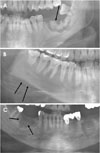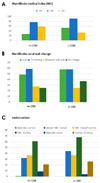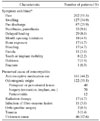1. Baltensperger MM, Eyrich GK. Osteomyelitis of the jaws. Berlin: Springer;2009.
2. Lee BD, Park MR, Kwon KH. Bisphosphonate-related osteonecrosis of the jaw in a multiple myeloma patient: a case report with characteristic radiographic features. Imaging Sci Dent. 2015; 45:199–203.

3. Ohe JY, Kwon YD, Kim YG, Lee BS, Yoon BW, Choi BJ. Features of histopathologic and radiographic findings in bisphosphonate-related osteonecrosis of jaw - clinical review. J Korean Assoc Oral Maxillofac Surg. 2008; 34:550–554.
4. Prasad KC, Prasad SC, Mouli N, Agarwal S. Osteomyelitis in the head and neck. Acta Otolaryngol. 2007; 127:194–205.
5. Marx RE, Tursun R. Suppurative osteomyelitis, bisphosphonate induced osteonecrosis, osteoradionecrosis: a blinded histopathologic comparison and its implications for the mechanism of each disease. Int J Oral Maxillofac Surg. 2012; 41:283–289.

6. Hansen T, Kunkel M, Weber A, James Kirkpatrick C. Osteonecrosis of the jaws in patients treated with bisphosphonates-histomorphologic analysis in comparison with infected osteoradionecrosis. J Oral Pathol Med. 2006; 35:155–160.
7. Hansen T, Kunkel M, Springer E, Walter C, Weber A, Siegel E, et al. Actinomycosis of the jaw - histopathological study of 45 patients shows significant involvement in bisphosphonate-associated osteonecrosis and infected osteoradionecrosis. Virchows Arch. 2007; 451:1009–1017.
8. Koerdt S, Dax S, Grimaldi H, Ristow O, Kuebler AC, Reuther T. Histomorphologic characteristics of bisphosphonate-related osteonecrosis of the jaw. J Oral Pathol Med. 2014; 43:448–453.

9. Choi SC. Clinical and radiographic analysis of 313 cases with osteomyelitis of the mandible. Oral Radiol. 1988; 4:19–25.

10. Ida M, Watanabe H, Tetsumura A, Kurabayashi T. CT findings as a significant predictive factor for the curability of mandibular osteomyelitis: multivariate analysis. Dentomaxillofac Radiol. 2005; 34:86–90.

11. An CH, An SY, Choi BR, Huh KH, Heo MS, Yi WJ, et al. Hard and soft tissue changes of osteomyelitis of the jaws on CT images. Oral Surg Oral Med Oral Pathol Oral Radiol. 2012; 114:118–126.

12. McLeod NM, Brennan PA, Ruggiero SL. Bisphosphonate osteonecrosis of the jaw: a historical and contemporary review. Surgeon. 2012; 10:36–42.

13. Ruggiero SL, Dodson TB, Fantasia J, Goodday R, Aghaloo T, Mehrotra B, et al. American Association of Oral and Maxillofacial Surgeons position paper on medication-related osteonecrosis of the jaw - 2014 update. J Oral Maxillofac Surg. 2014; 72:1938–1956.
14. Bast F, Groß A, Hecht L, Schrom T. Etiology and treatment of osteonecrosis of the mandible. Contemp Oncol (Pozn). 2013; 17:281–285.

15. Suei Y. Radiographic findings of bisphosphonate-related osteomyelitis of the jaw: investigation of the diagnostic points by comparison with radiation osteomyelitis, suppurative osteomyelitis, and diffuse sclerosing osteomyelitis. Oral Radiol. 2013; 29:121–134.

16. Devlin H, Greenwall-Cohen J, Benton J, Goodwin TL, Little wood A, Horner K. Detecting the earliest radiological signs of bisphosphonate-related osteonecrosis. Br Dent J. 2018; 224:26–31.

17. Bisdas S, Chambron Pinho N, Smolarz A, Sader R, Vogl TJ, Mack MG. Biphosphonate-induced osteonecrosis of the jaws: CT and MRI spectrum of findings in 32 patients. Clin Radiol. 2008; 63:71–77.

18. Ogura I, Sasaki Y, Sue M, Oda T, Kameta A, Hayama K. Tc-99m hydroxymethylene diphosphonate scintigraphy, computed tomography, and magnetic resonance imaging of osteonecrosis in the mandible: osteoradionecrosis versus medication-related osteonecrosis of the jaw. Imaging Sci Dent. 2019; 49:53–58.









 PDF
PDF ePub
ePub Citation
Citation Print
Print







 XML Download
XML Download